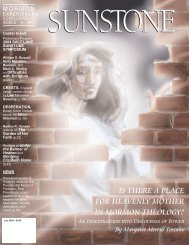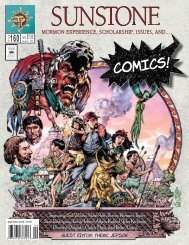00a_cover cmyk dark blue.qxp - Sunstone Magazine
00a_cover cmyk dark blue.qxp - Sunstone Magazine
00a_cover cmyk dark blue.qxp - Sunstone Magazine
Create successful ePaper yourself
Turn your PDF publications into a flip-book with our unique Google optimized e-Paper software.
S U N S T O N E<br />
human condition, what blessings and burdens we carry in<br />
this mortal sphere, are far too complex for my puny mind to<br />
sort through. I have enough trouble evaluating the good and<br />
bad in my own life. I am of the opinion that those who find it<br />
easy to pass judgment on their fellows are absolutely the<br />
wrong spirits to do so.<br />
As I continue my career representing those at the bottom<br />
of society, I have a better understanding of the forces that<br />
shape their lives—even the lives of those I feel like strangling.<br />
My advocacy is especially focused on learning about their<br />
lives and presenting their biography to the judge or jury who<br />
will decide their fate. I am both uplifted and distressed by<br />
what I see in my clients’ lives. What I observe does not diminish<br />
my faith in a kind, loving, and supportive Heavenly<br />
Father who wants his children to succeed and progress spiritually<br />
no matter what they struggle with.<br />
NOTES<br />
AUTHOR’S NOTE: Much of this essay has grown out of years of discussions with<br />
another LDS public defender specializing in the defense of death penalty cases,<br />
Dave Davis, a member of the Tallahassee Fourth Ward in the Tallahassee Florida<br />
Stake.<br />
1. In the interest of full disclosure, I should state my personal opposition to<br />
the death penalty. On that opposition see my article: “Reflecting on the Death<br />
Penalty,” Dialogue: A Journal of Mormon Thought, 29 (Summer 1996): 55–68. On<br />
various legal and historical aspects of the death penalty see: “‘A Current of<br />
Electricity Sufficient in Intensity to Cause Immediate Death’: A Pre-Furman<br />
History of Florida’s Electric Chair,” Stetson Law Review 22 (Summer 1993):<br />
1169–1209; “‘The Most Aggravated and Least Mitigated Murders’: Capital<br />
Proportionality Review in Florida,” St. Thomas University Law Review 11 (Spring<br />
1999): 207–88; with Mike Mears, “Georgia Death Penalty Law,” Georgia Survey<br />
Issue, Mercer Law Review 52 (Fall 2000): 29–47; and “Regulating the Five Steps of<br />
Death: A Study of Death Penalty Direct Appeals in the Florida Supreme Court,<br />
1991–2000,” St. Thomas University Law Review 14 (Summer 2002): 759–823.<br />
2. For instance, I will go to my grave believing that my client David Wayne<br />
Stoker, TDCJ #896, executed on 16 June 1997, did not commit the murder he<br />
died for. Chicago Tribune investigative reporters came very close to agreeing with<br />
me. See Steve Mills, Ken Armstrong, and Douglas Holt, “Flawed trials lead to<br />
death chamber,” Chicago Tribune, 11 June 2000, 1. On direct appeal, see Stoker v.<br />
State, 788 S.W.2d 1 (Tex.Crip.App. 1989). See also Texas Death Row (Atlanta:<br />
Longstreet Press, 2000), inmate 129.<br />
3. DeKalb County is a major part of metropolitan Atlanta. It contains about<br />
677,000 people, 54% of whom are African-American, 36% white, and 8%<br />
Hispanic. The county seat is at Decatur. Metropolitan Atlanta had 4,112,198 inhabitants<br />
according to the 2000 census, a little more than half the population of<br />
Georgia.<br />
4. My understanding of clients with these characteristics is very much influenced<br />
by the following books: James Garbarino, Lost Boys: Why Our Sons Turn<br />
Violent and How We Can Save Them (New York: Anchor Books, 1999) and Donald<br />
W. Black, Bad Boys, Bad Men: Confronting Antisocial Personality Disorder (New<br />
York: Oxford University Press, 1999).<br />
5. See Michael Dorris, The Broken Cord (New York: Harper & Row, 1989).<br />
Note also the Florida Supreme Court opinion on one FAS sufferer who murdered<br />
two people at Dillbeck v. State, 643 So.2d 1027 (Fla. 1994), cert. denied, 514 U.S.<br />
1022 (1995).<br />
6. The competency issue “‘is not, whether the defendant can distinguish between<br />
right and wrong, but is whether he is capable at the time of the trial of understanding<br />
the nature of and object of the proceedings going on against him<br />
and rightly comprehends his own condition in reference to such proceedings,<br />
and is capable of rendering his attorneys such assistance as a proper defense. . .<br />
demands.’” Echols v. State, 149 Ga.App. 620, 620–621, 255 S.E.2d 92 (1979). In<br />
practice, it is a very low standard.<br />
7. Harold I. Kaplan and Benjamin J. Sadock, Synopsis of Psychiatry, 8th ed.<br />
(Baltimore: Williams and Wilkins, 1998), 1138–1139.<br />
8. One description of those with an IQ in this range: “By their late teens,<br />
they can acquire academic skills up to approximately the sixth-grade level.<br />
During their adult years, they usually achieve social and vocational skills adequate<br />
for minimum self-support, but may need supervision, guidance, and assistance,<br />
especially when under social and economic stress.” See Diagnostic and<br />
Statistical Manual of Mental Disorders, 4th ed. (Washington, D.C.: American<br />
Psychiatric Association, 2000), 43. Other experts ascribe a mental age range of 8<br />
to 11 in adults with mild mental retardation. See John W. Jacobson and James A.<br />
Mulick, Manual of Diagnosis and Professional Practice in Mental Retardation, 2nd<br />
ed. (Washington, D.C.: American Psychological Association, 1997), 18. Adding<br />
to the complexity of this issue is the correlation between poverty and mental retardation.<br />
“Low socioeconomic groups seem to be over represented in cases of<br />
mild mental retardation, the significance of which is unclear. Current knowledge<br />
suggests that genetic, environment, biological, and psychological factors work<br />
additively in mental retardation.” See Kaplan and Sadock, Synopsis of Psychiatry,<br />
1140.<br />
9. Atkins v. Virginia, 536 U.S. 304, 122 S.Ct. 2242, 153 L.Ed.2d 335 (2002).<br />
See also Margaret Talbot, “The Executioner’s I.Q. Test,” New York Times <strong>Magazine</strong>,<br />
29 June 2003, 30.<br />
10. Psychiatrists understand this severe mental illness to be a mixture of<br />
schizophrenia and major depression. It will include uninterrupted periods of<br />
major depression and/or a manic episode, delusions or hallucinations for at least<br />
two weeks, may include disorganized speech, grossly disorganized or catatonic<br />
behavior, flat affect, and other symptoms. These conditions must not be the result<br />
of drugs or alcohol. Diagnostic and Statistical Manual of Mental Disorders, 4th<br />
ed., text revised [DSM-IV-TR], at 319–323.<br />
11. The murder victims were Mickey Bell, 56, and his wife Judy Bell, 52, of<br />
Ellaville, Georgia. Americus police described my client as a “demented person.”<br />
Christopher Sheets, “Double-murder stuns community,” Americus Times-Record,<br />
22 July 1996, 1.<br />
12. Statements from the court-ordered competency evaluation by Dr. Karen<br />
Bailey-Smith and Mr. Margaret Fahey, 21 October 1996, presently in the court<br />
files.<br />
13. Alia Beard, “Local football hero demands electric chair,” Americus Times-<br />
Record, 11 October 1998, 1-A; Elliott Minor, “Killer threatens jurors in effort to<br />
get chair,” Macon Telegraph, 7 October 1998, 3B.<br />
14. Colwell v. State, 273 Ga. 634, 544 S.E.2d 120 (2001). See also Bill Rankin,<br />
“Georgia’s high court backs death sentence of killer,” Atlanta Journal-Constitution,<br />
3 March 2001, 114.<br />
15. Bill Rankin, “Football hero turned killer hangs self on death row,” Atlanta<br />
Journal-Constitution, 14 January 2003, D9, and Trisha Renaud, “Man who sought<br />
execution sills self,” Fulton County Daily Report, 4 January 2003, 1. This young<br />
man’s case was the subject of a 60 Minutes II segment and an A&E American<br />
Justice program.<br />
16. Adrain Nicole LeBlanc, “Prison Is a Member of Their Family,” New York<br />
Times <strong>Magazine</strong>, 12 January 2003, 28–30.<br />
17. For insights into the lives of women defendants, I recommend Wally<br />
Lamb, ed., Couldn’t Keep It To Myself (New York: Regan Books, 2003), a collection<br />
of biographical essays by women prison inmates.<br />
18. David Simpson, “Prostitute admits to 3 slayings, blames pimp,” Atlanta<br />
Journal-Constitution, 17 January 2004, E1. Note also the sympathetic profiles by<br />
Mara Shalhoup in the Atlanta weekly Creative Loafing, “Learning to hit a lick,”<br />
4–10 March 2004, 34, and “Learning to hit a lick, part II,” 11–17 March 2004,<br />
34.<br />
19. Garbarino, Lost Boys, 34–35.<br />
20. Ibid., 49.<br />
21. Ibid, 50.<br />
22. Denzel Washington’s excellent movie Antwone Fisher, based on the autobiography<br />
of Antwone Fisher, Finding Fish (New York: Harper/Torch, 2001), impressively<br />
demonstrates the impact of parental abandonment on the life of a<br />
young man.<br />
23 Gospel Principles (Salt Lake City: Church of Jesus Christ of Latter-day<br />
Saints, 1992), 296.<br />
24. I was interested to read about President James E. Faust observing recently,<br />
“The older I get, the less judgmental I become.” Quoted in Dallin H.<br />
Oaks, “Judge Not and Judging,” Brigham Young University fireside, 1 March<br />
1998, http://speeches.byu.edu/reader/reader.php?id=2548 (accessed 12<br />
September 2006).<br />
SEPTEMBER 2006 PAGE 39

















